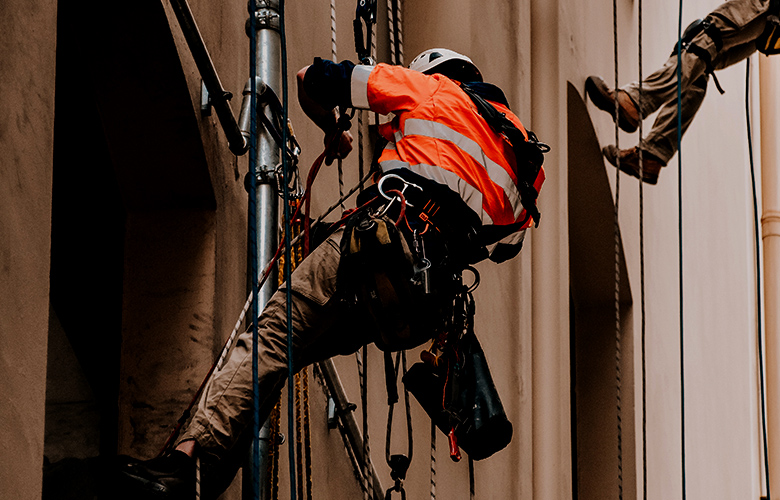
As a freelancer, I’m often working in different venues and each venue usually has its own way of doing things, different layout and design, different fall protection systems and different rescue plans. Each company puts together their rescue plans based on a few different factors but the reality is, ask 10 riggers how they would get somebody down and you’ll likely hear 10 different answers with some strong arguments behind it. Well, here comes one of them.
These are the techniques that I rely on to raise and lower a live load from a fall protection system. Let’s set some ground rules first:
Rigged to Lower: Common in the rope access/fire rescue world, systems are built using releasable devices that can be operated remotely as the technician performs his tasks. The rescuer operates the rescue system from a safe location and can efficiently extract an incapacitated tech. As it turns out, most horizontal lifelines you find in arenas aren’t rigged for lowering, only designed to catch a fall.
Self Rescue: After a fall, a technician can reach a safe area without assistance from other technicians. This is an ideal situation because it usually means the injuries are minimal.
Assisted Rescue: In an assisted rescue the responsibilities and roles of the rescue are distributed amongst personnel which offers an organized and efficient solution to rescue situations. In assisted rescue, one technician will be responsible for the rigging and operation of the raising/lowering system and another technician will be responsible for rigging a COD pulley and casualty handling. Clear and precise communication is essential to a successful rescue.
Intervention Rescue: Intervention rescues are the least preferred rescue as it puts another technician at risk and puts nearly all of the responsibility on the tech performing the rescue. These are also called pick-off rescues. In most situations the rescuer must raise the casualty off of a hard point and then be lowered to safety.
If possible, and it usually is in an arena or theatre, plan for an assisted rescue. Use the team; as they say, many hands make light work. Avoid intervention rescues as it increases risk due to exposure of hazards and puts the load on one technician. With the right equipment, most would-be intervention rescues can be handled from the anchors if located at a safe area by a single technician.
It’s great when harnesses catch you from falling, but, they also have some disadvantages that could become life threatening after a fall. Suspension Trauma occurs when the brain doesn’t receive enough oxygen due to the restriction of the harness. When the brain doesn’t receive enough oxygen rich blood, it shuts down resulting in fainting. As we all know, a lack of oxygen can cause brain damage so the sooner you can get a casualty out of suspension, the better.
How fast the on-set occurs varies from person to person as it really comes down to your overall health, in particular, cardiovascular health. Signs of Suspension Trauma include: paleness, profuse sweating, increased heart rate, numbness of extremities and fainting. If you suspect Suspension Trauma has set-in, call paramedics immediately.
Rescue Kits all contain similar elements that achieve the same two goals. Raising and lowering. What are you going to use to lift somebody off a Y lanyard? What are you going to use to lower?
This is a really versatile kit that can go over edges and allows for assisted and intervention rescues. With the HaulerBiner in the mix, it provides up to 7:1 mechanical advantage to lift the casualty with ease. However, this kit requires a fair amount of training to become proficient.
Rigging Configurations
Anchor-Sling-HaulerBiner-D4 OR Anchor-Sling-D4-Inside HaulerBiner (for a little extra pull)
Knot Selection
This kit is great for ladders and vertical environments. It has simple functionality that allows for easy raising and lowering. This is an auto descender used often in the wind industry that we find incredibly versatile in multiple industries. It lends itself well to the theatrical and arena environments just because simplicity of use and there’s usually a nice stage or arena floor under you. This unit requires very little training and skill retention is high.
1. Sternal D-Ring. The sternal D-ring puts the casualty in a more comfortable and seated position which makes casualty management easier.
2. Dorsal D-Ring. The dorsal D-ring is a great place to make an attachment however, it is extremely uncomfortable to be hung up by the dorsal in a rope access style harness. This makes Suspension Trauma more of an issue as the casualty remains upright throughout the process.
3. Rescue Rings on Lanyard – if you can’t get a hold of the sternal or dorsal, use the rescue ring on the energy absorbing lanyards to lift the casualty. Not all lanyards have rescue rings.
4. Captive Eye of the Y lanyard Snaphook. This one is an ugly one but it works. If you clip into the captive eye of the snap hook, you’ll only need to lift the casualty only a few inches before you can free the snap hook from the anchor and lower to safety. It might take a little wiggling but it can be done. If you’re working near an edge and you’re worried about side loading a carabiner, tie directly in to the captive eye using a follow through figure 8.
Link to Trevor’s Website:

Rigging Safety: Your Life is in Your Hands
Working At Height: What’s In Your Rigging Kit?


Trevor started a career in rigging after completing an internship with Cirque du Soleil. He was hired as an on-call Rigger at "Viva Elvis". After a year as an on-call, he was hired to tour with "Corteo" on the European leg of the tour. As a young rigger, for Trevor, this show was like going to university. It was full of professional and personal challenges that became some of the most influential moments of his life. In 2012, Trevor was hired to do the creation of Michael Jackson "ONE" in Vegas. Currently, Trevor spends his time bouncing back and forth between rope access projects on stadiums, bridges and wind turbines and work-at-height training. He owns a company called Rope Technologies based out of Las Vegas and they teach riggers how to work-at-height safely. Trevor's goals are to push the overall safety of work-at-height industries with a specific focus on theatrical safety. Trevor is married Noemie Dube-Dupuis and has 3 kids, Lola, Theo and Mila. They reside in Las Vegas. Qualifications: SPRAT 3/Trainer IRATA 3 ANSI Z359.2 Competent Rescuer/Trainer First-Aid, CPR, AED OSHA 30 ASNT Visual Testing I & II Key Projects: Cirque du Soleil’s “Viva Elvis”- Rigger Cirque du Soleil’s “Corteo”- Rigger Cirque du Soleil “Michael Jackson ONE” Creation Team- Rigger
Read Full Profile© 2021 TheatreArtLife. All rights reserved.

Thank you so much for reading, but you have now reached your free article limit for this month.
Our contributors are currently writing more articles for you to enjoy.
To keep reading, all you have to do is become a subscriber and then you can read unlimited articles anytime.
Your investment will help us continue to ignite connections across the globe in live entertainment and build this community for industry professionals.